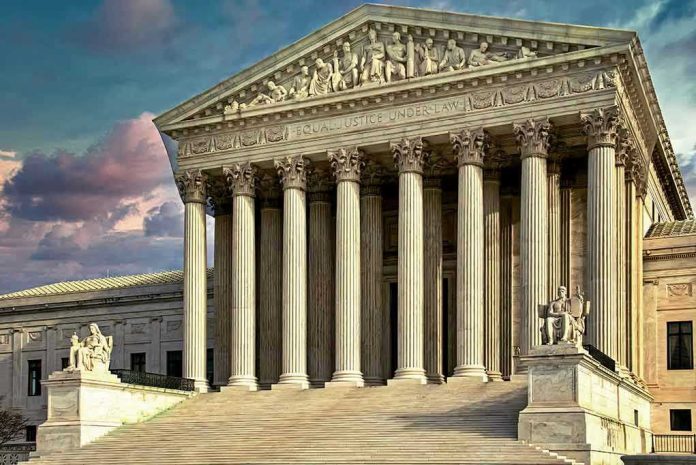
The Supreme Court is set to make a groundbreaking decision that could redefine the boundaries of gun ownership for marijuana users.
Story Snapshot
- The case questions if marijuana users are considered drug users only when high.
- Potential impacts on Second Amendment rights for drug users.
- Complex intersection of federal and state laws on marijuana use.
- Implications for future legal interpretations of drug use and gun ownership.
Marijuana Use and Gun Ownership: A Legal Conundrum
The Supreme Court’s upcoming decision could profoundly affect the rights of individuals who use marijuana and other drugs to own firearms. At the heart of this issue is whether marijuana users are considered drug users only when under the influence, or if their use categorically disqualifies them from gun ownership. This question poses significant challenges in balancing federal law, which prohibits drug users from owning guns, and state laws where marijuana use is legal.
The case could set a precedent that influences the interpretation of the Second Amendment concerning drug use. With marijuana legal in many states yet still federally banned, the court’s decision could either uphold or challenge existing federal restrictions. This has sparked debate about the rights of individuals who legally use marijuana under state law but face federal prohibitions on firearm ownership.
Second Amendment Rights at Stake
The intersection of drug use and gun ownership rights is fraught with complexities. The Second Amendment guarantees the right to bear arms, yet federal law restricts firearm ownership for those deemed unlawful users of controlled substances. This case forces a reevaluation of what constitutes an unlawful user, particularly in an era where marijuana legalization is expanding. The outcome could redefine who is eligible to exercise their Second Amendment rights, potentially creating a new class of excluded individuals.
Many argue that denying gun rights based on marijuana use contradicts common sense, especially in states where such use is legal. The court’s decision may address whether current federal laws unjustly penalize individuals who are otherwise law-abiding citizens. This raises broader questions about the compatibility of drug policy and constitutional rights.
BREAKING: The Supreme Court will consider whether people who regularly smoke marijuana can legally own guns. https://t.co/gx4eFlqiBm
— The Associated Press (@AP) October 20, 2025
The Federal and State Law Dichotomy
The legal discord between federal and state marijuana laws creates a complex backdrop for the Supreme Court’s decision. Federally, marijuana remains a Schedule I drug, categorically illegal, yet numerous states have legalized its use for medical and recreational purposes. This dichotomy places individuals who comply with state laws in a precarious position regarding gun ownership. The court’s ruling could harmonize or further complicate these legal contradictions.
The potential ramifications extend beyond marijuana users. If the court rules in favor of gun rights for marijuana users, it could pave the way for similar challenges concerning other substances. This could lead to a reevaluation of federal drug classifications and their impact on constitutional rights, prompting a broader discussion about drug policy reform.
Broader Implications for Legal Interpretation
A decision by the Supreme Court in this case could have lasting implications on how drug use and gun ownership are interpreted legally. It could influence future cases and legislative actions concerning the rights of individuals who use substances that are legal at the state level but illegal federally. This decision could become a cornerstone for debates about the balance between public safety and individual rights.
The court’s ruling will likely resonate beyond the immediate issue of marijuana users, potentially affecting broader interpretations of constitutional rights in the context of evolving social norms and legal landscapes. As society grapples with changing attitudes towards drug use, this case could shape the future discourse on the relationship between personal freedoms and public policy.













